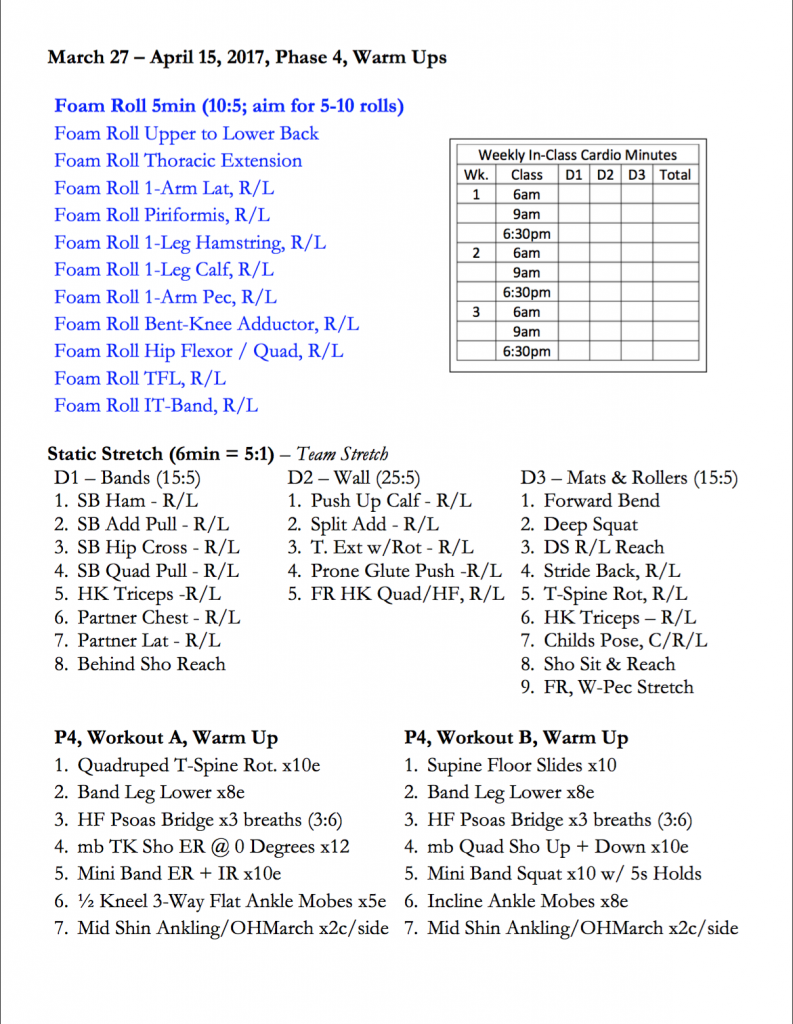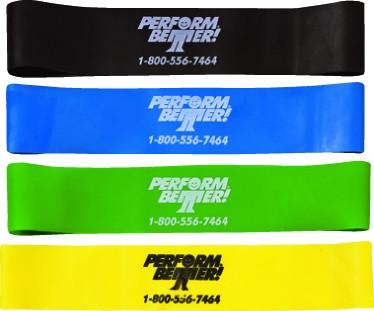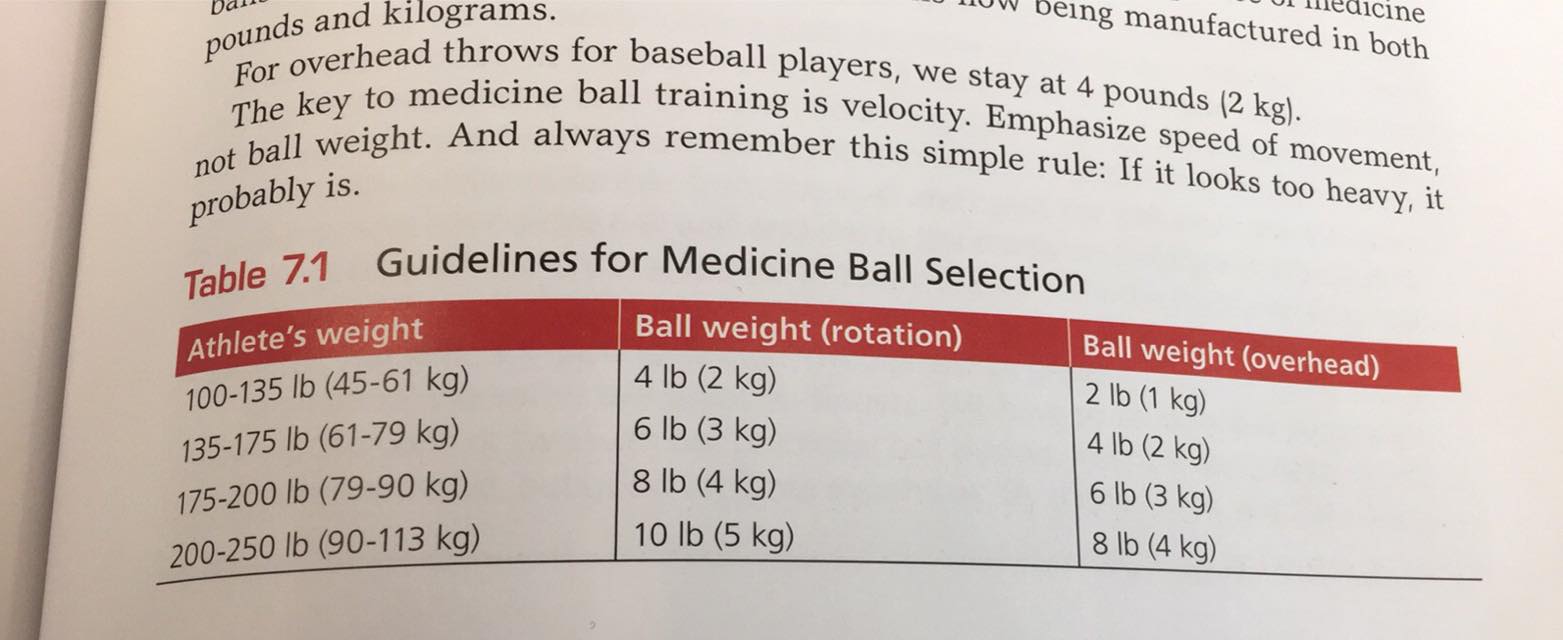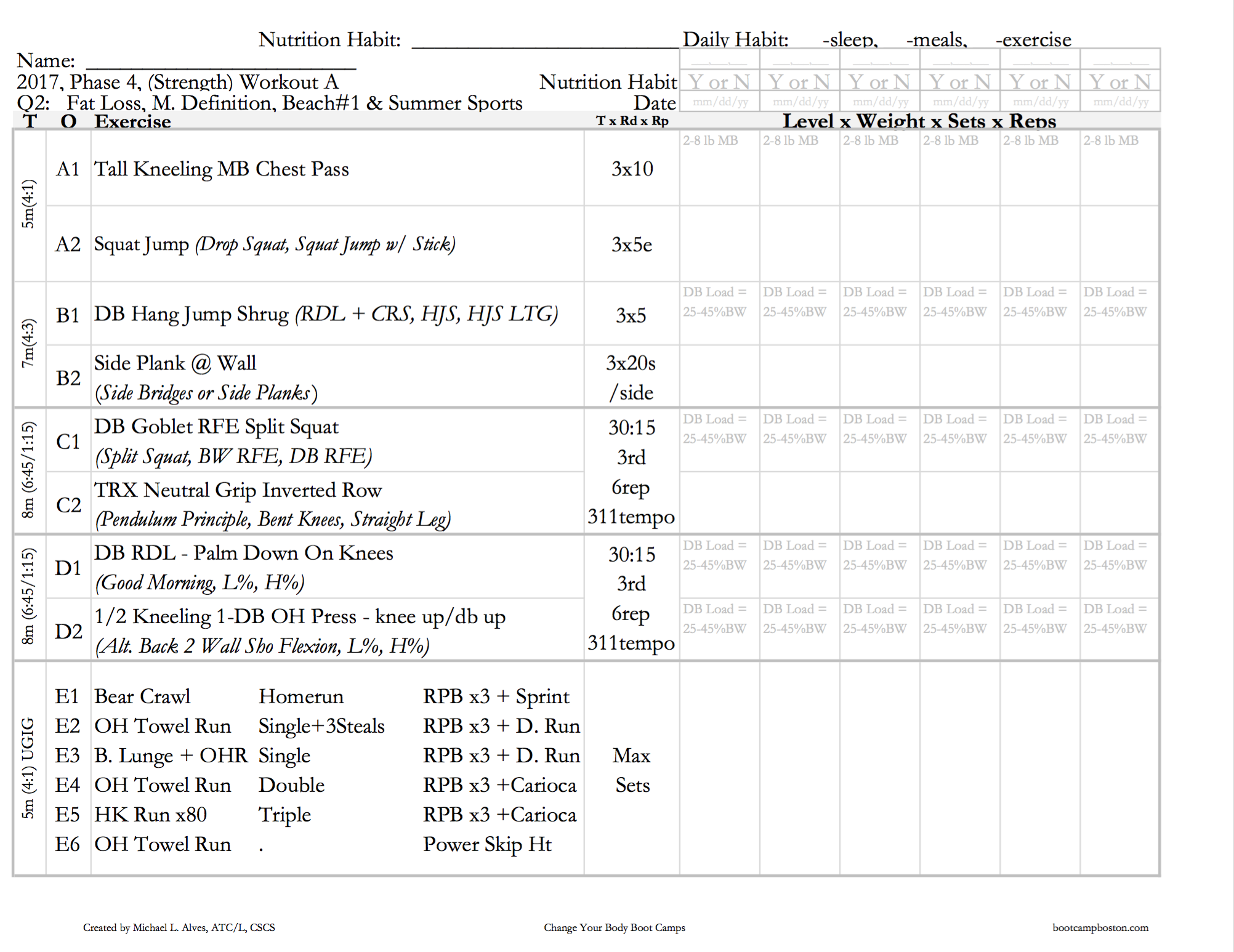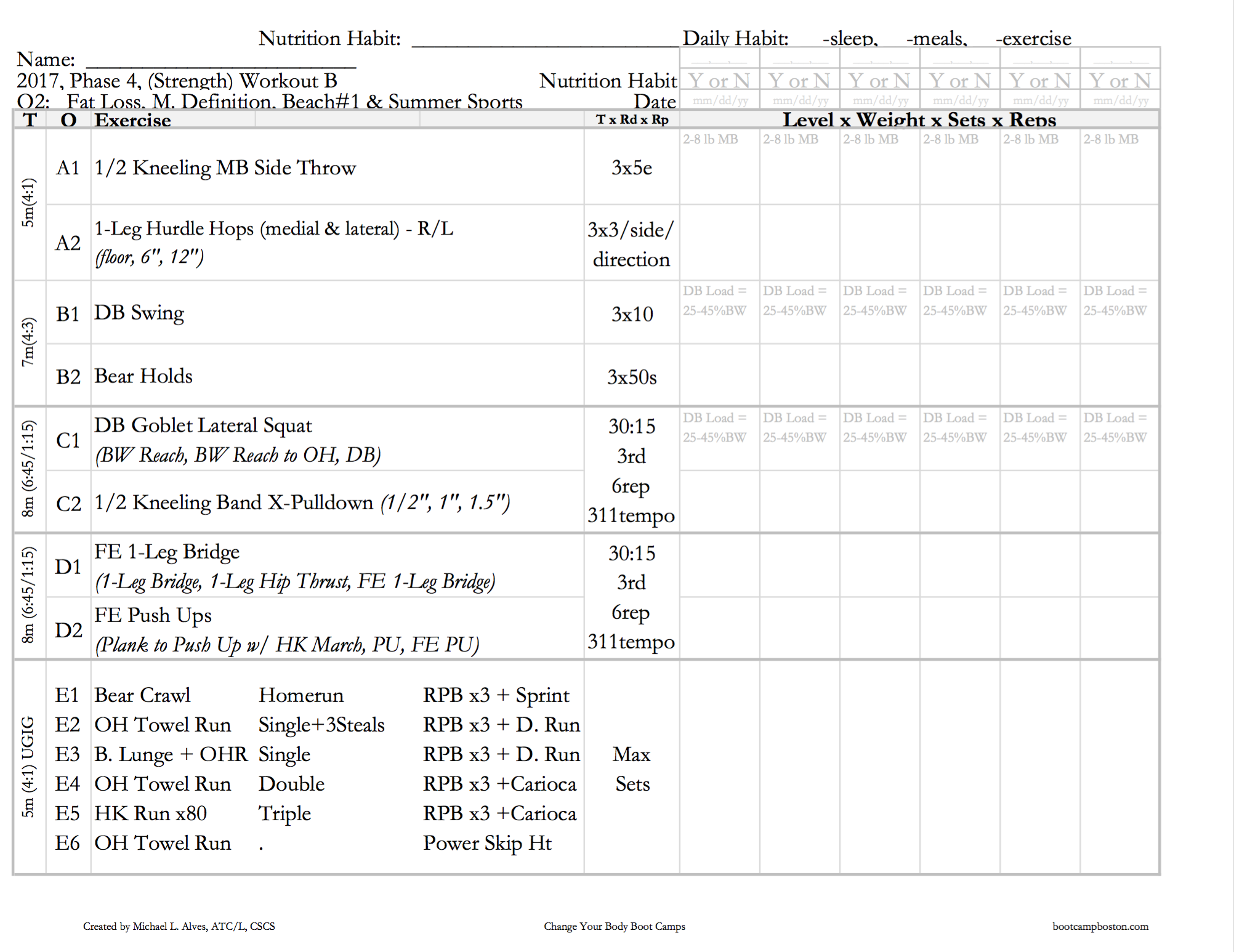Happy Spring to you!
Are you ready to change and keep getting better? I hope so because our fast workouts from Q1 are continuing with fresh changes and the return of stations.
Q2, P4 Overview
The theme for the quarter is Fat Loss, Muscle Definition, Beach Season #1 and Summer Sports Training. The style of workouts we’ll be doing in Phase 4 are metabolic strength. We started with performance testing to track progress from the start of the year and we’ll finish this quarter with performance testing. We’ll be moving the static stretch cool down to the beginning of the workout to follow the foam rolling routine. We’ll be introducing speed and agility training following movement prep. Stations will return first with Medicine balls, paired with plyometrics (jumps). DB Loads will be increasing (25-45%BW) to compliment fat loss, muscle building and performance to get you beach and summer sports ready. You’ll first experience this with the return of explosive power training paired (hang jump shrugs and swings) paired with a core stability exercise. Strength training will consist of 2 circuits of 3 sets done for 3 rounds with a 311 tempo for 6 reps (did you get all that?). TRX, benches and bands are back. Marisa and I will be teaching do this, don’t do that, do this for most exercises. We’ll explain why you’re doing something during the workout or whenever you ask, to speed up demos and make week 1 feel like week 2, and week 2 feel like week 3. Conditioning will decrease to a 4 minute density set while we’re learning this phase. Triathlon relay will be full court with a new backwards lunge to overhead reach and overhead towel runs during every transition. Base running stays the same with the exception of the order. The multi-direction day will have a Ready Position Bounce x3 followed by the sprint series and a return of Power Skips for Height. When conditioning is done, we’ll ask you, “would you please help us pick up all the equipment and then record, once the floor is clear”. We’ll teach you how to pack up the ladder, hurdles, mini bands, load the medicine balls, take down the TRX’s, bag the Tennis Balls and return the cones. It’ll feel fast, collaborative and we’ll all develop a greater sense of stewardship, camaraderie and commitment. We’ll finish with our cheers and go from there.
Quarterly Theming
Fat Loss, Muscle Definition, Beach Season #1 and Summer Sports Training. What does this mean? First! Remember the population we train and the style of programming we do. We work with busy people who are or were out of shape and are looking to get in their best shape. They’re looking to lose weight, decrease body fat and inches, develop more muscle tone, firmness vs softness and muscle definition. They want to have more endurance or stamina, more energy, more strength. They want to perform better in life, whether at home, work, with their family or in their sport. They could do and maybe do exercise on their own, but they also value and want a caring coach who’s an expert at what they do; a results oriented program to follow that is both fun, consistent yet varied, will help them get better and reduce their risk for injury. They want to have a recurring appointment, be held accountable, track their progress and learn new skills. They want to be a part of an awesome, high energy and fun culture that they can look forward to going to, be apart of and contribute to. They want to train with nice, motivating people who aren’t there to complain or whine. They’re not looking to lift maximum weights, do CrossFit or use barbells for example. They want metabolic workouts to improve their strength and conditioning. Help them to get and/or stay lean.
O.K. Got all that. So last phase we did fast, team training workouts for weight loss. This phase we’re doing strong, station training workouts for fat loss, muscle building and performance training, hence the heavier DB loads. What if you want to lose weight and/or move fast? The program is designed to be metabolic regardless of the season. This means if you follow the nutrition plan without training, you should lose weight. If you add in metabolic training you should lose weight faster. If you don’t follow the nutrition plan then you’re bodyweight will either stay the same or increase as it’s real difficult to lose weight without improving your nutrition.
Emphasis on fat loss means your body fat mass should decrease based on the style of training we’re doing if you choose the right levels, loads and have a sufficient stimulus. This should happen with the scale staying the same, going down or going up because you should decrease your body fat %. It’s very individual at this stage because some people could gain weight from lean mass, while losing body fat and the scale could read more, equal or less.
Muscle definition means we’re doing 6 reps under a strict tempo with an increase in DB Load. Naturally when you lift a heavier weight, you should get stronger. When you get stronger, control the tempo and have sufficient stimulus (e.g. if it’s 6 reps you should feel like you can do 8, but not 9 reps), your body should respond by building more muscle. Building more muscle means you’re less soft, placid, loose or atrophied and more firm, tone, solid and defined. You have better shape.
Beach Season #1 means we’re being proactive and working to get you and everyone bathing suit ready. So help yourself by schedule a trip or day at the beach, getting a hot bathing suit, scheduling a photo shoot, do some self-care grooming / spa treatments and get your mindset and body ready for the beach. This is the quarter where you might do extra credit / tutoring / workouts to work on specific areas of importance for you. If you want tailored workouts like the Custom Corrective Cardio (C3), let me know.
Summer Sports Training
You may not play a sport now, but you might in the future. You may not play or participate in a sport now because you don’t have the time, conditioning level or interest, but it’s coming. Parents, you know you’re going to gain time at some point. Kids are only supposed to be home for 18 years and they get drivers licenses at 16.5, so you know its coming. You’re only supposed to be out of shape for so long, so at some point when you keep making time for yourself and doing thoughtful things you should outgrew old un-useful habits and living 2 lives, start living 1 life and reap the benefit of all your efforts. The tortoise wins the race every time you read the book, so you will too. Endurance sports are the perfect compliment to your cardio goal. Swim, bike, run, triathlons, rowing (crew, kayaks, canoe) and obstacle course races (OCR’s) are great endurance sports. Also great endurance sports are surfing, kiteboarding and stand up paddle boarding. Great summer sports that aren’t endurance sports and are individual or team sports are tennis, golf, baseball, softball, lacrosse, ultimate frisbee, grass and beach volleyball. Laugh at the thought of it now and then relish in eating your words later.
Strong Workouts
Strong workouts means the weight, resistance or skill level is increasing and the reps are decreasing. You’ll have insufficient recovery so these are metabolic strength workouts.
Performance Testing: “One and Done, Fast & Fun!”
Some people have created an association with the testing days, that leads them to choose not to train instead of capturing a golden opportunity to get better and receive valuable feedback. I may have made the mistake of putting testing at the start of the quarter to capture baselines following an empowerment week. I thought the desire to perform well would inspire members to crush challenge workouts, minutes, sleep and do whatever it takes to peak for testing, but it’s not the norm. So instead of banging my head against the wall further, I’ll “test” moving it to the end of the quarter to replace the last in class team challenge. Those workouts are super high energy because they’re the culmination of 12 weeks of effort, so what better time to test yourself with a “One and Done, Fast and Fun” workout than when you have great momentum from face to face coaching. (Testing is important for a myriad of reasons, which you can list a bunch of them yourself. One I’ll share is that you need to dust off that top gear, so it’s sharp when you need it. Use it or lose it!”)
Static Stretching
The New Functional Training for Sports by one of my mentors, fellow Springfield College alum and one of the greatest strength & conditioning coaches in the world, who happens to be based out of Woburn, MA, Mike Boyle shared so many amazing things I can’t wait to use. One of which is static stretching at the beginning of the workout after rolling. First, many people static stretch something prior to their workout instinctively, whether it’s your calves, hips, glutes, lats, chest, …. so this is normal. Also following foam rolling allows the tissue quality / fascia to be improved first, then lengthened. Get a massage or self-massage, then stretch. Makes sense right? Next, static stretching cold vs. hot, Coach Boyle hypothesizes, has some sort of plastic deformation of the tissue that lasts, where as static stretching warm or hot, certainly makes it easier for the tissue to lengthen, but it might not last as long or as well. I’m an athletic trainer, which means I’m always trying to reduce both of our risks for injury and that includes during the workout and after the workout, so if static stretching cold, helps to reduce your injury risk by stretching your muscles in a way that lasts, thereby reducing your injury risk further during the workout, then let’s give it a shot.
A couple of caveats. Static stretching before maximal effort sprints and jumps has been show to decrease performance. This is bad, however that’s only if you do a static stretch immediately before a sprint or jump or something. We’ll be doing this during the 2nd 5minutes of your workout and you’ll have another 10minutes + of recovery and neuromuscular activation and dynamic stretching before we challenge your performance, so it should not deter performance, but rather enhance it.
Last. One of the main reasons we’ve always done static stretching at the end of the workouts is to facilitate recovery, recycle lactic acid, lengthen tissues while they’re warm because they’re more pliable, turn down your Sympathetic Nervous System (fight or flight) and turn up your Parasympathetic Nervous System (rest & digest). So it certainly has value. If training was higher on your priority list, as in you were a professional, Olympic and/or collegiate athlete, we/you might do more low intensity cardio for 5-20 minutes after your workout to facilitate recovery, then stretch, then massage, then hot & cold whirlpools, treatment, contrast showers, etc…But alas, we’re making lemonade and doing the best we can with our 60 minutes of scheduled self-care each week.
Mini Bands
One of the best ways to reduce your risk of injury on the lower body, specifically the knee is train the hip rotators, specifically the Glute Medius. We do that with single leg exercises like SLDL’s, Inverted Hamstrings, 1-Leg Squats, etc… and with our lateral & linear band walks to name a few. Since the hip is a circumducting, ball and socket joint like the shoulder, it also has a rotator cuff. It’s been challenging to directly isolate it in our Do Anywhere Workouts while using minimal equipment because of the lack of equipment. I’ve decided that it’s time to introduce mini bands.
We’ll use them in our warm ups for the quarter. They’re fairly inexpensive. $20 on Amazon
and Perform Better.
They’re extremely portable, useful and practical, but they’re also very delicate if you get lazy, especially when you’re tired. So…I’d like you to buy a pack from me if you don’t already have them. I did a large bundle purchase (48 Mini Band 4-Packs), so I’ll sell a pack to you for $10. I’ll also show you the proper way with great technique emphasis on how to put them on and take them off so they last you a long time. Plus when you turn in your $10, I’ll give you a velcro tie to keep them together. You don’t have to buy them from me and you can use mine, but if you break one of mine after declining to purchase the 4-pack, the replacement cost will be $15 for a single band.
We’ll use the mini bands for both lower body and upper body training. You’ll gain an appreciation for them and the multi-pack will help you determine the right resistance for you.
Speed Training & Agility Training
I always thought and kind of knew I might introduce some more of this or specifically the ladders and tennis ball drops, but it was a timing thing. I still think it’ll work and I think it’s a great compliment, but we’ll have to find out. Speed and agility training are best when your nervous system is fresh because your asking for maximal neuromuscular recruitment. They’re also super fun. They’ll follow movement prep and come before the Core & Power training. Workout A will have tennis ball drop, speed training from a half kneeling position. You’ll be doing a You Go I Go (UGIG) with a partner for as many reps as you can in 3 minutes. Your partner and you will have to find the right distance so you can catch the ball before the 2nd bounce. Check out these 2 videos for a sample of what’s to come. I don’t have a pre-shot video, so each of these explain what our “Half Kneeling Sprint w/ A Tennis Ball Drop” will look and feel like.
Station Training vs. Team Training
Station training is where we rotate around the gym between stations, usually in a paired exercise, tri-set or circuit format. This requires demonstrations for each pair, tri-set or circuit, which is an unappealing side effect because you have to watch more and do less compared to team training where everyone does the same thing at the same time and I can demonstrate while we workout. We go faster and do metabolic acceleration workouts during team training which makes the loads and resistance lighter and a better compliment for weight loss. You’re usually less sore and sometimes not as hungry.
The station training allows you to develop your athletic skills, do a greater variety of exercises, use different exercises tools, move throughout the gym vs. staying in one place, get stronger from greater loads and resistance from external sources or putting your body in challenging positions that makes it hard to do a lot of reps (e.g. pull ups vs. dumbbell rows, feet elevated push ups vs floor push ups, 1-leg squats on a box vs. reverse lunges).
Medicine Balls & Plyometrics
Medicine balls will work on upper body explosiveness and speed strength. This is useful because you use it or lose it. It keeps your reflexes sharp and fast and helps you to react explosively with force against an external object if needed. There is tremendous carryover to sports (hitting ball or opponents), self-defense (defending against attacks, attacking and counterattacking) and activities of daily living (maybe you’re gardening and you have to throw rocks; something falls off the table or a kid falls and you have to instantly grab it or the person). They’re super fun too.
Here is a recommended MB Load based on body weight. This is a starting guideline. Which means weaker, heavier people might need a lighter ball and stronger, lighter people might need a heavier ball. This should look fast. If it looks slow, I’ll move you down. If you’re so fast you can’t control the catch, I’ll move you up.
Plyometrics mean jumps, hops, skips, bounds. Putting force into the ground causing you to leave the ground and then landing safely from the effort. Again. Use it or lose it. These are fun, are great for shaping and changing the composition of your lower body and have a direct carry-over to life and sports. Life could be jumping over a puddle and landing safely. Sports are any jump, hop, bound, skip or recovery from one of these. Learning how to land is more important than high or well you can jump, hop, bound or skip. Learning how to land and doing it well reduces your risk of injury. Most significant lower body injuries result from the inability to decelerate and land properly. We’ll be doing jumps or lateral jumps (both on 2 feet) and practicing sticking the landing for a phase. Then we’ll progress to jumping over hurdles and sticking the landing, then jumping over hurdles and recovering with a double bounce. The next quarter we’ll introduce hops (1-leg) both linear (forward) and lateral (side to side) in a similar pattern: stick, hurdle and stick, hurdle and double bounce and last hurdle reactive repeats.
Power & Stability
Most every adult as they age get stiffer, lose joint range of motion, get soft & unstable in the core and butts, lose power, lose lean muscle and lose bone density. We address all of these every workout. This is the power lean muscle, bone density and stability section. Why do you care about power? Use it or lose it. Have you ever accelerated onto a highway while driving a car with horsepower? Have you ever seen an old person get off the toilet, out of the car or climb stairs or get off the ground? That’s power. Power is usually associated with maximum effort for few reps or 1 rep. We’ll be introducing DB Olympic Lifts over the next couple quarters and we’ll start with DB Hang Jump Shrugs and DB Swings progressions. These are super fun, give you super hot shapes and muscles and contribute to a feeling of virility, pheromones if you believe in that stuff and life and sports performance. Recommended DB Loads are 25-45% BW, however, lighter loads may be necessary because technique is CRUCIAL. Use light DB loads or lower level progressions first until your technique is flawless and then increase your loads. Between what you feel and what we see, we should be able to help you use the right loads. When in doubt, go light, use common sense and ask.
Core Stability training is a great way to reduce your lumbar injury risk, transfer force from your legs to your upper body and back and feel more solid. A great perk to stability training is that you’re often doing an isometric contraction, which means holding still, not moving. This has a side benefit of providing muscle tone, firmness and definition, while decreasing the muscles circumference. This means your waist should get smaller if you’re also eating only to 80% full and not to overeating. We’ll work on anti-extension, anti-rotation and anti-lateral flexion. 3 important injury prevention planes for the lumbar spine.
Strength Training
This phase our metabolic strength will use DB Loads of 25-45% Body Weight. There will be exercises you don’t even use weights on, so we’ll work to get the appropriate resistance to give you the necessary stimulus for change. The work to rest tempos will be 30:15. There will be a 2 exercise pair per strength circuit. Each strength circuit will have one left / right exercise (e.g. RFE Split Squat – L+R, 1/2 Kneel 1-DB Overhead Press – L+R, Lateral Squat – L+R and FE 1-Leg Bridge – L+R). This means you’ll do 3 sets per round. There will be 3 rounds. Your rep tempos will be 311. 3 count lowering, 1 count holding and 1 count up. The hold could be in the bottom or top position depending on the exercise. 3+1+1 = 5. This means each rep should last 5 seconds. 5 seconds into 30seconds means you should get 6 reps per exercise. If you finish before the set is over you went too fast. If you finish after the set, you went too slow. You want Goldilocks porridge. 6 reps is just right. 6 reps also is in the strength training range, which means if you want to get stronger (you do), build more lean muscle (you do), gain more muscle definition and shape (you do), improve your bone density (you do), gain more energy (you do), decrease body fat (you do), lose inches (you do) and perform better in life, sports, work and your relationships, then you have to have a sufficient stimulus. You should feel like you could do 6-8 reps, but not 9. 9 means it’s too easy and you need to add more resistance or do a higher skill level. 5 reps means it’s too hard, unless it’s your last set, which is o.k.
2017, P4, Workout Card
Strength Exercises
One thing I learned a long time ago and that was re-emphasized in Boyle’s New Functional Training for Sports Book, is the balance between 2-legs and 1-leg, squat pattern and hinge pattern exercises. We have 2 workouts, A&B. On Workout A this phase we have lower body strength exercises of DB Goblet RFE Split Squat and DB RDL’s. That’s a 1-leg squat pattern for the Rear Foot Elevated (RFE) Split Squat and a 2-leg hinge pattern for the DB Romanian Dead Lift (RDL). Workout B we do lower body strength exercises of 2-Leg Lateral Squats and 1-Leg FE Bridges. That’s a 2-leg squat pattern and a 1-leg hinge pattern respectively. I also try to balance pushes with pulls, upper with lower, internal rotation with external rotation work w/ rest and strength with cardio ratios to name a few. This thoughtful balance helps to get you in better balance with better posture. Many strength training programs have too great of emphasis on the show muscles and not enough emphasis on the go muscles. This imbalance can lead to great mirror muscles and some performance benefits, but a greater risk for injury and not complete performance benefits.
Since we’re on the subject of show muscles, the FE (Feet Elevated) Push Ups will target the upper chest (under the collar bone), which is a very aesthetic area to target. The Inverted Rows will counter this posture while training your whole posterior chain isometrically similar to how the push up trains your whole anterior chain isometrically. Remember what I wrote earlier about isometric training. Muscle definition with a decrease in circumference in most cases (poor diet and too high of volume training can lead to increased circumference).
The 1/2 Kneel 1-DB Overhead Press will help develop the front of the shoulder (deltoids or little pumpkins), the traps (some say traps are the new six pack) and triceps (bottom of the arm). Doing 1 side at a time both works correcting Left / Right imbalances, but it also isolates your core by taking your lower body out of the equation, stretches your hips and works on anti-rotation, anti-lateral flexion and anti-lateral extension. The 1/2 Kneeling X-Band Pulldown will be our opposite to the Overhead Press working on scapular retraction, downward rotation and depression vs. the protraction, upward rotation and elevation of the scapular you see in the Overhead Press. It’ll also work the back of the shoulder, the mid back, biceps, triceps and lats, while again isolating the core by taking the lower body out of the equation.
The bridge is in there because Boyle points out a great tip for injury reduction that every program should have a hinge (2-leg and 1-leg), a hip bridge (1-leg or 2-leg) and a knee curl. There’s no knee curl this phase, but there are plenty of other hip injury prevention exercises like the mini band hip internal / external rotation and mini band squats. The bridge also helps to give a great shelf to your back side for both performance and aesthetics.
Conditioning
We’ll be decreasing the total conditioning time from the 10 minutes last phase to 4 minutes this phase. There’s a lot of foundational teaching this phase / quarter with the return of stations and new equipment, so we’re borrowing conditioning time for the time being. Notable changes are triathlon relay is now full court, base running order changes and the multi-direction day has a (3) ready position bounces before the sprint and a return of the power skip for height.
Nutrition Habit
Time to pick a new nutrition habit. Remember you want to win, so stack the deck in your favor. Pick the next nutrition habit to add to the one’s you’re currently practicing. You continue doing the other habits and now only track the new habit you choose. You want to feel like you have a 9 out of 10 confidence level that you can do this habit every day. It could be 6 meals per day, 5 meals, 4 meals, 3 meals, 2 meals or 1 meal, meaning everyday. If you get more than 1 “No” or “X” on your workout card or personal journal / planner, then it’s too difficult. Make it easier or pick a new one.
Choose now, start practicing and record it on both sides of your workout card and your compliance with it.
Cardio Minutes & Challenge Workouts
Reply to the email I sent or send me a text with your cardio minutes for
Week 2 (W2): ###
Week 3 (W3): ###
Empowerment Week (EW): ###
and include the total # of Challenge Workouts you did last week.
Challenge Workouts (CW’s): #
Send them now and then come back.
Guest Week
As I continue to help you get in your best shape will you continue to help me grow my business? Yes?
The last 7 years I’ve steered my energy towards my personal life for both joy and heartache. My home life is getting more solid and stable everyday (fingers crossed) and I’m able to put more time into myself and my business (CYBBC). You’ve already seen the 24 cones set up everyday. You’ve noticed the 4 stations, which are built for 6 people per station. It’s time to fill the class and create a waiting list like I did with my personal training schedule back when I was a top trainer and a couple of times in CYBBC. You may have concerns about larger class sizes, which is normal and fair, and so do, but aside from the initial hiccups that come with change, it’ll be better for all. You’ll get a greater performance from Marisa and I because we’ll be nervous as sh*t, so we’ll prepare better and have greater energy to give. You’ll experience greater camaraderie and energy in the program, which will lead you to do better because of the culture WE’VE built together. There will be plenty of opportunities for 1-on-1 time (private measurements, phone check ins, tailored workouts (C3) and small group settings (Fun Runs like Cold Spring Park, Blue Hills Hike, Stadium Runs, Carson Beach Workout and Spartan Race Training). Plus Marisa says and many have echoed that we should have more frequent as in biannual at most or annual in the least, gatherings (e.g. cookouts and dinner & dancing). Plus, you already know I grew up in an environment that cares (both parents are nurses), so I care about you and if something isn’t going right for you, then it matters to me. Let me know.
So. Would you be a walking talking billboard for my business as I continue to help you get in your best shape?
Here are 3 Ways you can do it!
- Referral: Guest Week and/or 1 Week Trials
- Testimonials: yelp (BG), yelp (MC), google (BG), google (MC), facebook, LinkedIn and bootcampboston.com (email me).
- Bonus points for pics
- Double bonus points for video
- Networking: human resources, invites and public speaking.
Feel free to check them all off and be a CYBBC Ambassador. That’d be pretty cool. Then tell me how I can thank you for it all.
This week is guest week, as is the 1st week of every phase, except September, which is Guest Month.
Tip: We have a 6 Week Stretch coming up for phase 5 & 6. No empowerment week between them, so we/you should peak for testing, measurements and beach season. I’m planning my marketing to capitalize on this and you should be planning on how to capitalize on this opportunity to peak for summer.
That’s all for now! It was a lot. Bookmark this page if you need to come back to it. Text, email, call or come early/stay late at BC if you have a question, comment, or other.
Change Happens Here!
Your coach,
Mike Alves
Burn & Earn!

